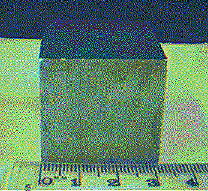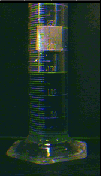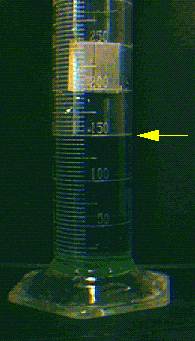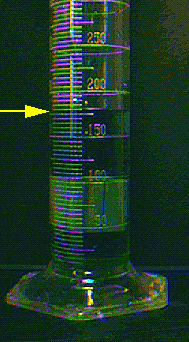How to find the volume of a solid object.
Volume is the amount of space an object occupies.
The volume of an object can be calculated geometrically using mathematical equations or by measuring liquid displacement.
In the experiment below you will measure the volume of a cube using the formula V=(side)x(side)x(side) and by using a graduated cylinder to measure liquid displacement.
Case I. Finding volume geometrically.
What is the volume of the metal cube shown here (to the nearest tenth of a cm)?

Case II. Measuring Volume using a graduated cylinder.
It is also possible to find the volume of an object by measuring the volume of water that it displaces.

What
will happen when we lower the above metal block slowly into a graduated cylinder
containing water?
What was the amount of water displaced by the object?
 Before
Before After
After
Please enter your
answer in the space provided. If you need a calculator one is available. to
the right.
Notice that both methods give fairly accurate values for the volume of the cube. Why are the volumes not exactly the same for the two methods used? What are some factors that will determine the accuracy of your measurements?
How does the volume of a cube vary with the area of one of its surfaces? With the length of one side of the cube?
Type in any value for length and then click on one of the other boxes.
Please continue to the next chapter!
Please continue to the next chapter on density
Or search for more specific information on Mass -- Density -- Volume
- - -Or return to the Science and Math Activity Home Page
Mass Volume Density Activities
Mass: Learn how to measure the mass of an object using a triple beam balance
Mass vs. Weight: Mass and weight are often confused by many students. Learn the difference and try some challenging problems.
Volume: Measure volume using a graduated cylinder.
Density of a Solid: Learn to calculate the density of an unknown solid from knowing its mass and volume.
Density of a Liquid: Learn to calculate the density of an unknown liquid from knowing its mass and volume using a graduated cylinder and triple beam balance. Learn what a hydrometer is, and what it can do.
Density Challenge: Great page for gifted and talented students! Some excellent challenging problems.
Assessment: Twenty questions on mass, volume and density (two levels of difficulty). Your test is marked online.
Science Project Ideas: Ideas for science projects using mass, volume and density concepts learned from this module.
Mass Volume Density Lab Exercise: Problem: What is the relationship between water pressure and depth of water?
An Integrated Math Science and Art (STEAM) Activity- Mass, Volume Density Activity using the Gates Project from Central Park NYC.
